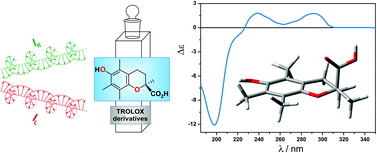Chromane helicity rule – scope and challenges based on an ECD study of various trolox derivatives†
Abstract
The validity of the chromane helicity rule correlating the sense of twist within the dihydropyran ring with the CD sign of the 1Lb band observed at ca. 290 nm in their electronic circular dichroism (ECD) spectra is examined using a set of natural (S)-trolox derivatives. To investigate both the scope and the limitations of the rule a combination of ECD spectroscopy, especially the temperature dependence of the ECD spectra, single crystal X-ray diffraction analyses, and density functional theory (DFT) calculations was used. A thorough conformational analysis supported by the X-ray data led to the identification of predominant conformers. Then, a comparison of the experimental ECD spectra with the spectra simulated by TDDFT calculations allowed for a reasonable interpretation of the accumulated data. The results clearly indicated that to avoid the possibility of erroneous conclusions the chromane helicity rule should be used with great caution. This is likely related to the conformational flexibility of tested compounds by which conformers of different helicities can be produced. Therefore, based on the results presented here, it is strongly recommended that the conclusions derived from analysis of experimental data are supported with the appropriate theoretical computations.


 Please wait while we load your content...
Please wait while we load your content...